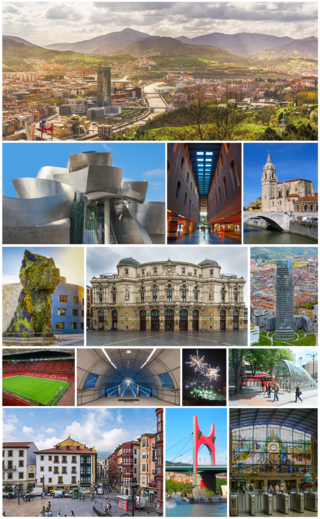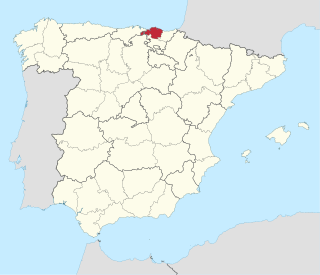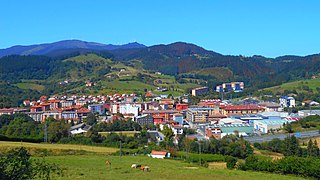
Bilbao is a city in northern Spain, the largest city in the province of Biscay and in the Basque Country as a whole. It is also the largest city proper in northern Spain. Bilbao is the tenth largest city in Spain, with a population of more than 347,000 as of 2023. The Bilbao metropolitan area has 1,037,847 inhabitants, making it the most populous metropolitan area in northern Spain; with a population of 875,552, the comarca of Greater Bilbao is the fifth-largest urban area in Spain. Bilbao is also the main urban area in what is defined as the Greater Basque region.

Biscay or Bizkaia, is a province of the Basque Autonomous Community, heir of the ancient Lordship of Biscay, lying on the south shore of the eponymous bay. The capital and largest city is Bilbao.

The Basque Country is the name given to the home of the Basque people. The Basque Country is located in the western Pyrenees, straddling the border between France and Spain on the coast of the Bay of Biscay.

Gipuzkoa is a province of Spain and a historical territory of the autonomous community of the Basque Country. Its capital city is Donostia-San Sebastián. Gipuzkoa shares borders with the French department of Pyrénées-Atlantiques at the northeast, with the province and autonomous community of Navarre at east, Biscay at west, Álava at southwest and the Bay of Biscay to its north. It is located at the easternmost extreme of the Cantabric Sea, in the Bay of Biscay. It has 66 kilometres of coast land.

Atxondo is a municipality located in the province of Biscay, in the Basque Country, Spain. Atxondo is part of the comarca of Durangaldea and has a population of 1,447 inhabitants as of 2007 according to the Spanish National Statistics Institute.

Elorrio is a town and a municipality located in the eastern part of the province of Biscay, in the Basque Country, in northern Spain. As of 2017, it has a population of 7,307 inhabitants. It covers an area of 37.20 square kilometers and it has a population density of 193.58 people per square kilometer. It holds the medieval title of Most Loyal and Noble Villa.

Ermua is a town and municipality located in the province of Biscay, in the autonomous community of Basque Country, northern Spain. In 2019, Ermua had 15,880 inhabitants.

Mallabia is an elizate, town and municipality located in the province of Biscay, in the Basque Country, northern Spain. Mallabia is part of the comarca of Durangaldea and has a population of 1.135 inhabitants as of 2006 and according to the Spanish National Statistics Institute.

Zaldibar is an elizate, town and municipality located in the province of Biscay, in the Basque Country, Spain. Zaldibar is part of the comarca of Durangaldea and has a population of 3,043 inhabitants as of 2019 and according to the Spanish National Statistics Institute.

Biscayan, sometimes Bizkaian, is a dialect of the Basque language spoken mainly in Biscay, one of the provinces of the Basque Country of Spain.

The Autopista AP-8 is a toll autopista in the north of Spain, crossing the Basque Country from east to west. It is known as the Autopista del Cantábrico and connects the French border with Bilbao via San Sebastián, Zarautz, Eibar and Durango. At Bilbao the AP-8 continues as the toll-free Autovía A-8, which runs along the Spanish northern coast to Gijón and eventually the region of Galicia.
Eneko Bóveda Altube is a Spanish professional footballer who plays as a right-back or central defender.
The Biscay Regional Championship(Campeonato Regional de Vizcaya), also called the North Regional Championship(Campeonato Regional Norte) in its early editions, was an official football tournament in Spain organised by the North Football Federation.

Debabarrena is an eskualdea / comarca located in Gipuzkoa, Basque Country (Spain). It has an area of 180,3 km2. It is north from the comarca of Debagoiena, east from the province of Biscay, and south from the Gulf of Biscay.
Jon Errasti Zabaleta is a Spanish former professional footballer who played as a defensive midfielder.

The Basque Football Federation is the body responsible for managing association football in the Basque Country autonomous region. Its offices are in Bilbao.
The term Basque derbies refers to the various local derbies between the football teams based in the Basque Country, Spain. This can also include the province of Navarre outside of the autonomous community. It specifically refers to individual matches between the teams, but can also be used to describe the general ongoing rivalry between the clubs and fans.
Association football has been a part of Basque Country culture since the end of the 19th century. As of 2023, three Basque teams play in La Liga, the top division of the Spanish football system: Athletic Bilbao, Real Sociedad and Deportivo Alavés.
The Gipuzkoa autonomous football team was the regional football team for the province of Gipuzkoa, Spain, active between the 1910s and the 1930s. They were never affiliated with FIFA or UEFA, because Gipuzkoa is represented internationally by the Spain national football team.
The Biscay autonomous football team was the regional football team for the province of Biscay, Spain, active between the 1910s and the 1930s. They were never affiliated with FIFA or UEFA, because Biscay is represented internationally by the Spain national football team.






















